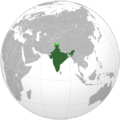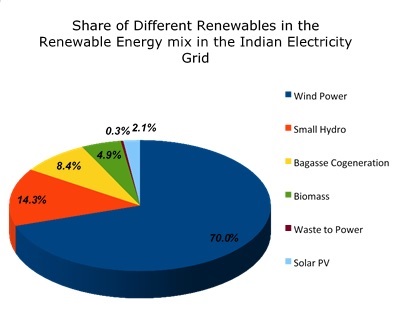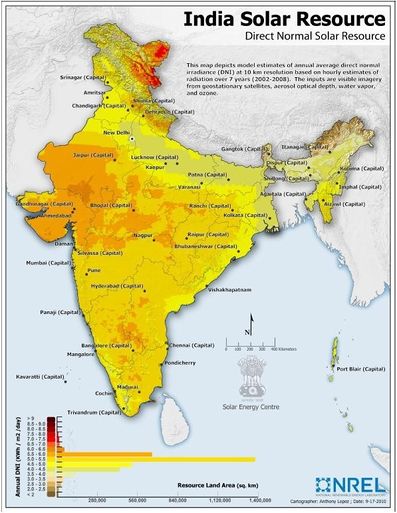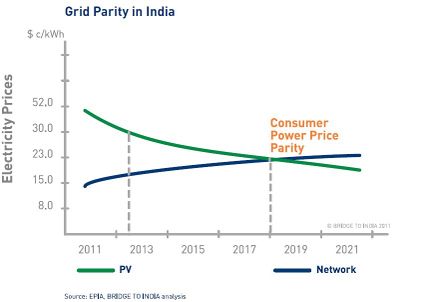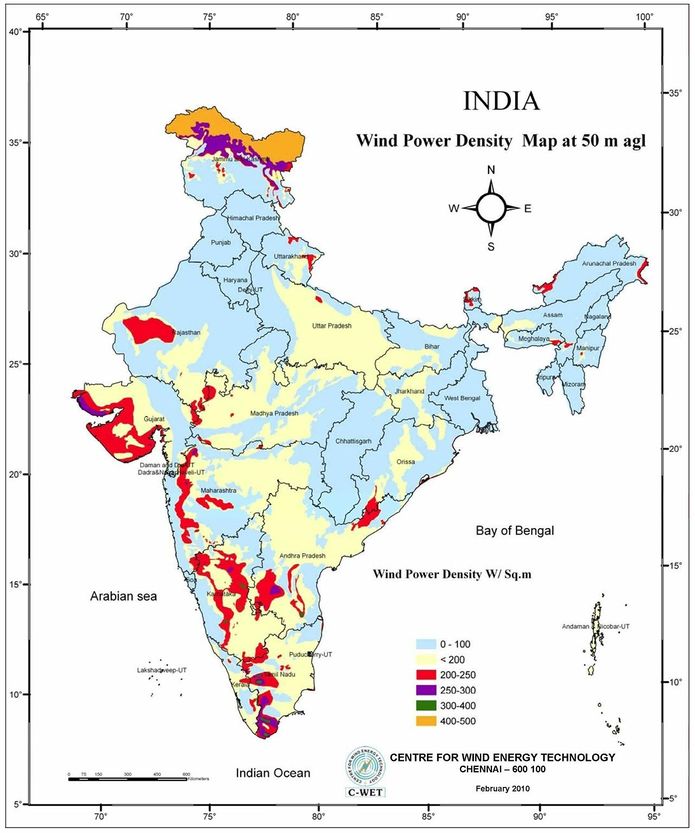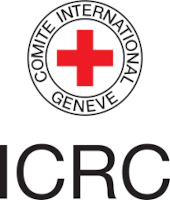Knowledge fuels change
For over a decade, Energypedia has shared free, reliable energy expertise with the world.
We’re now facing a serious funding gap.
Help keep this platform alive — your donation, big or small, truly matters!
Thank you for your support
Difference between revisions of "India Energy Situation"
***** (***** | *****) |
***** (***** | *****) m |
||
| Line 623: | Line 623: | ||
[[India Energy Situation#toc|►Go To Top]] | [[India Energy Situation#toc|►Go To Top]] | ||
| + | [[Category:South_Asia]] | ||
| + | [[Category:India]] | ||
[[Category:Country_Energy_Situation]] | [[Category:Country_Energy_Situation]] | ||
| − | |||
| − | |||
| − | |||
Revision as of 12:35, 13 October 2014
Capital:
New Delhi
Region:
Coordinates:
21.0000° N, 78.0000° E
Total Area (km²): It includes a country's total area, including areas under inland bodies of water and some coastal waterways.
XML error: Mismatched tag at line 6.
Population: It is based on the de facto definition of population, which counts all residents regardless of legal status or citizenship--except for refugees not permanently settled in the country of asylum, who are generally considered part of the population of their country of origin.
XML error: Mismatched tag at line 6. ()
Rural Population (% of total population): It refers to people living in rural areas as defined by national statistical offices. It is calculated as the difference between total population and urban population.
XML error: Mismatched tag at line 6. ()
GDP (current US$): It is the sum of gross value added by all resident producers in the economy plus any product taxes and minus any subsidies not included in the value of the products. It is calculated without making deductions for depreciation of fabricated assets or for depletion and degradation of natural resources.
XML error: Mismatched tag at line 6.2 ()
GDP Per Capita (current US$): It is gross domestic product divided by midyear population
XML error: Mismatched tag at line 6. ()
Access to Electricity (% of population): It is the percentage of population with access to electricity.
XML error: Mismatched tag at line 6.no data
Energy Imports Net (% of energy use): It is estimated as energy use less production, both measured in oil equivalents. A negative value indicates that the country is a net exporter. Energy use refers to use of primary energy before transformation to other end-use fuels, which is equal to indigenous production plus imports and stock changes, minus exports and fuels supplied to ships and aircraft engaged in international transport.
XML error: Mismatched tag at line 6.no data
Fossil Fuel Energy Consumption (% of total): It comprises coal, oil, petroleum, and natural gas products.
XML error: Mismatched tag at line 6.no data
Introduction
India is a rapidly growing economy which needs energy to meet its growth objectives in a sustainable manner. The Indian economy faces significant challenges in terms of meeting its energy needs in the coming decade. The increasing energy requirements coupled with a slower than expected increase in domestic fuel production has meant that the extent of imports in energy mix is growing rapidly[1]. India is among the top five Green-house-gas (GHG) emitters globally[2]. To reduce its dependency on the conventional sources, India has launched a solar mission in 2009. The Mission has set a target of 20,000 MW using solar. Solar Mission stipulates implementation and achievementof the target in 3 phases (first phase upto 2012-13, second phase from 2013 to 2017 and the third phase from 2017 to2022) for various components, including grid connected solar power.[3]
India has a population of over 1.21 billion (2011 census) with 70% of total population living in rural areas.Out of these 1210 million people, 396 million (44.7% of the total rural population compared to 7.3% of urban population) does not have access to electricity and 592 million (rural- 62.5%; urban- 20.1%) people still use firewood for cooking . Majority of these people reside in rural areas and are still dependent on non-commercial energy sources, such as fuel wood, crop residue, and animal waste for their energy needs. Furthermore, about 80% of the population - which includes 28% of urban inhabitants - still relies on combustion of biomass fuels for cooking activities. The use of biomass for cooking also contributes to the indoor air pollution phenomenon, which caused 488.200 deaths in 2004 .[4]
Electricity Consumption in India was about 543 KWh/capita in 2009, among the lowest in the world. Although India has considerably improved its generating capacity, it still has difficulty in meeting demand and there are persistent power shortages which constrain India’s economic growth. With the development of the industrial and commercial sectors as well as the wider use of electrical equipment, electricity demand keeps increasing.Moreover, approximately 30 percent of India’s generated power is lost in transmission. Distribution is the weakest link of India’s power supply chain as it faces substantial technical losses (because of overloading of transformers and conductors, for instance) and commercial losses of electricity (because of low metering efficiency, poor billing and collection, large scale theft of power). Furthermore, lack of transmission and distribution of power to less densely populated areas which are located far away from the power generating stations is the major reason for not being able to achieve 100 percent electrification in the country.
Energy Situation
[Show/hide]
The installed capacity of power plants in India as on 29.02.2012 is 1,90,593 MW (including 22,253 MW from Renewable Energy Sources). The gross electricity generation in the country during 2011-12 "up to February, 2012) including import from Bhutan was 798.9 Billion Units. The energy requirement, availability and shortage in the country during April, 2011 to February, 2012 are given below:[5]
Year |
Energy Requirement (MU) |
Energy Availability (MU) |
Deficit (MU) |
Deficit (%) |
2011-12 (till Feb 2012) |
853324 |
782124 |
71200 |
8.3% |
State-specific Energy Information
[Show/hide]
Renewable Energy
[Show/hide]
India also has one of the highest potentials for harnessing the renewable energy as it is bestowed with such natural resources and geographical and climatic conditions that could support the promotion of renewable energy technologies like solar, wind, biomass and small hydro.
As on 31st January, 2012, the total installed capacity of grid connected Renewable Energy is 23.12 GW. Amongst this, the biggest chunk is from Wind power, which stands at around 16, 000 MW. The wind power sector growth in India is continuously increasing and around 2100 MW of wind power was added in the last year and it is expected to continue because of the continued government supported schemes in this sector.
Till last year, the share of grid connected Solar PV was negligible, only around 40 MW and most of the Government focus was on Off grid Solar PV and Residential Solar Thermal. However, due to the new government initiative- Jawaharlal Nehru National Solar Mission (announced in year 2010), the Grid connected Solar PV and the Concentrated Solar Power Market is on the boom. Around 440 MW of Solar PV was installed in the last year and is expected to increase many folds due to highly lucrative government schemes.
Small Hydro and Biomass technologies represent the remaining chunk of the Grid connected Renewable Energy mix, as shown in the graph below. Government also sees Geothermal Energy as an interesting Renewable Energy source for India and few sites in Andaman Nibobar Islands etc have been identified for the pilot projects.
Solar Energy
India has high Solar Insolation levels with about 300 clear sunny days –most parts of the country receive 4-7 Kwh/m²/day with about 1500-2000 sunshine hours per-week (depending upon location ) , which is far more than current total energy consumption . Ministry of New and Renewable energy (MNRE), Government of India estimates solar potential at over 10000 MW. States on West part of India such as Rajasthan and Gujrat have the highest potential.Parts of these states have the best solar irradiance in India with 4-7 Kwh/m²/day.
Grid Parity in India
Photovoltaic (PV)
-> Photovoltaic (PV) Pumping in India
Solar Thermal
-> Solar Thermal Applications in Industries in India
Solar Water Purification
-> Solar Water Purification (in India)
Wind Energy
India is the world’s fifth largest producer of wind power after Denmark, Germany, Spain, and the USA[7] Reported installed capacity by Dec 2011: 16084 MW Ranked as the 5th country with the largest installed capacity. During the year 2011 India added 3019 MW of wind power.[8]
Biomass
The potential for power production from captive and field-based biomass resources, using technologies for distributed power generation, is assessed at 19 500 MW including 3500 MW of exportable surplus power from biogas-based in sugar mills.[9]
Biogas
Hydro Power
The hydro electric potential in India has been estimated to be 150,000 MW[10]. As on March 2005, only about 31 has either been developed or is being developed. In the last decade the development of hydroelectric power has slowed down. The reasons include high capital investment, time lag between feasibility studies and commissioning, environmental requirements and public opinion etc. Recently Ministry of Power has initiated several steps to accelerate the capacity addition of hydroelectric projects to utilize hydroelectric potential of the country. Hydroelectric initiative for development of 162 new hydroelectric plants spread across 16 states in the country with aggregate 47,930 MW has been launched[11].
Electricity Situation
[Show/hide]
Electricity is the most important component of primary energy.Access to affordable and reliable electricity is critical to a country’s growth and prosperity. The country has made significant progress towards the augmentation of its power infrastructure. In absolute terms, the installed power capacity has increased from only 1713 MW as on 31 December 1950 to 118 419 MW as on March 2005.Even the per capita electricity consumption rose from merely 15.6 kWh in 1950 to 592 kWh in 2003/04. However, it is a matter of concern that per capita consumption of electricity is among the lowest in the world.
In the recent years, India’s energy consumption has been increasing at one of the fastest rates in the world due to population growth and economic development. Industrial consumers are the largest group of electricity consumers, followed by the domestic, agricultural and commercial consumers, in that order.Primary commercial energy demand grew at the rate of six per cent between 1981 and 2001Unknown Object. India ranks fifth in the world in terms of primary energy consumption, accounting for about 3.5% of the world commercial energy demand in the year 2003 . Despite the overall increase in energy demand, per capita energy consumption in India is still very low (15.9 Million Btu) compared to other developing countries (Thailand: 57.9; China: 56.9)[12]
For the past two decades, India has had to face increasing deficit in power supply, both for meeting its normal energy requirements as well as its peak load demand. The problem is acute during peak hours and summers, and necessitates planned load shedding by many utilities to maintain the grid in a healthy state. The average all-India shortages in 2009-10 were at 10 per cent in terms of normal energy requirement and about 13 per cent in terms of peak load.
Although India is increasing dependent on commercial fuels, a sizeable quantum of energy requirements (40% of total energy requirement), especially in the rural household sector, is met by non-commercial energy sources, which include fuel wood, crop residue, and animal waste, including human and draught animal power. However, other forms of commercial energy of a much higher quality and efficiency are steadily replacing the traditional energy resources being consumed in the rural sector.
Electricity Demand and Supply
Table summarizing the electricity demand and supply in India[13]
Fiscal Year (FY) |
Energy |
Peak Demand | ||||||
(MU) |
(MW) | |||||||
| Demand |
Availability | Shortage | % | Demand | Met | Shortage | % | |
| 2002-03 |
545,983 | 497,890 | 48,093 | 8.8 | 81,492 | 71,547 | 9,945 | 12.2 |
| 2003-04 |
559,264 | 519,398 |
39,866 | 7.1 | 84,574 | 75,066 | 9,508 | 11.2 |
| 2004-05 | 591,373 | 548,115 | 43,258 | 7.3 | 87,906 | 77,652 | 10,254 | 11.7 |
| 2005-06 | 631,024 | 578,511 | 52,513 | 8.3 | 93,214 | 81,792 | 11,422 | 12.3 |
| 2006-07 | 693,057 | 624,716 | 68,341 | 9.9 | 100,715 | 86,818 | 13,897 | 13.8 |
| 2007-08 | 737,052 | 664,660 | 72,392 | 9.8 | 108,866 | 90,793 | 18,073 | 16.6 |
| 2008-09 | 777,039 | 691,038 | 86,001 | 11.1 | 109,809 | 96,785 | 13,024 | 11.9 |
| 2009-10 | 830,594 | 746,644 | 83,950 | 10.1 | 118,472 | 102,725 | 15,747 | 13.3 |
However, the Indian Power Ministry has been trying to increase its generating capacity by adding to it every year.
Generating capacity addition during the Tenth Plan (2002-2007) & Anticipated generating capacity by the end of the Eleventh plan (2007-2012) (in MW)[14]
|
|
Hydro |
Thermal |
Nuclear |
RE |
Total |
|
Installed Capacity as on 31 March 2002 |
26269 |
74429 |
2720 |
1628 |
105046 |
|
addition during 10th plan |
7886 |
12114 |
1080 |
6132 |
27212 |
|
Installed Capacity as on 31 March 2007 |
34654 |
86015 |
3900 |
7760 |
132329 |
|
Proposed addition during 11th plan |
15627 |
59693 |
3380 |
14000 |
92700 |
|
Total capacity antidipated as on 31 March 2012 |
50281 |
145708 |
7280 |
21760 |
225029 |
Electricity Access Rate
According to the Ministry of Statistics and Programme Implementation, 100% of the towns are electrified, whereas 83.7% of the villages are electrified. However, 45% of rural households do not have access to electricity and over 1 million households have no access to any form of modern energy or lighting.
2009 (IEA[15])
- Electrification rate - 66.3%
- Population without electricity - 403.7 million
2008 (IEA[16])
- Electrification rate, total - 64.5%
- Electrification rate, urban - 93.1%
- Electrification rate, rural - 52.5%
- Population without electricity - 404.5 million
Power Shortages
Rapid growth of the Indian economy places a heavy demand on electric power and this adds to the shortage of power already glaring at us. This shortage of power and lack of access acts as major constraints on the economic growth. Average peak shortages excluding scheduled load shedding was estimated at 12% and average energy shortages at 11 % in 2008-09. Power shortages hint towards an insufficient generating capacity and inadequate transmission and distribution networks. To a great extent this is the outcome of poor financial health of the State Electricity Utilities having high levels of Aggregate Technical and Commercial (AT&C) losses. AT&C losses of most of the State Power Utilities (SPUs) are currently high at above 35%. Due to this, these utilities have had only limited success in attracting private investors to set up power plants.[17]Moreover, poor quality of power supply and frequent power cuts and shortages impose a heavy burden on India’s fast-growing trade and industry. A crowd sourcing information webpage on power cuts in India has been in operation since 2011: [1]
Key Problems of the Energy Sector
[Show/hide]
Rising Oil Imports: As per IEA Energy Statistics, India's oil consumption has increased six folds in the last 25 years and oil already accounts for almost one- third of India's energy use. To meet the increasing demand, India imported 95.86 Million Tonnes of crude oil in 2004/05 contributing to 75 % of the total supply[18]. The oil demand has pushed India to make deals with countries—such as Sudan, Syria, and Iran. Such high import dependency is associated with the risks of disruption in supplies on account of large crude oil imports that can have serious repercussions on the economy.
Inferior Quality of Coal: India is the third largest producer of coal in the world. Major portion of coal produced is consumed by the power sector. The poor quality of Indian coal and the lack of infrastructure to clean it and also the associated transportation of coal are the causes of environmental pollution and associated economic burden[19].
Inefficient Electric Systems: Although 80 percent of the country has access to electricity, unreliable power grids and inefficient electric systems result in loss of power along the delivery chain. State electricity boards run the infrastructure for power distribution but they are in poor financial conditions. Although the government has loosened limitations on foreign investment in the power sector, the notion of working with the financially beleaguered electricity boards has scared off private investment.
Policy Framework, Laws and Regulations
[Show/hide]
As per the Indian Electricity Grid code 2010, it has been made mandatory for each Indian state to generate/ purchase a minimum amount of electricity through Renewable Energy (Renewable Energy Purchase Obligation). Further, each state utility has special schemes (preferential tariffs) for the purchase of Renewable Energy Electricity. For instance, the Feed in tariff of wind power varies from 4 Euro cents to 9 Euro cents depending on state to state and the wind power density in the state. Moreover, as per the CERC guideline, Solar and Wind power falls in MUST RUN category and they can be asked to shut only when there are security concerns for the Grid. Similary, each state has different schemes for different renewable energy source as per the potential of renewable energy source in the state. [20]
- Electricity Act_2003.pdf Electricity Act 2003: The act consolidating the laws related to generation, transmission, distribution, trading and use of electricity and laying out the general conditions for creating a conducive environment for the development of electricity industry.
- Electricity (Amendment) Act, 2003
- Integrated Energy Policy Report, August 2006: A long term energy policy perspective has been provided by the report which provides policy guidance on energy- sector growth.
General Energy Policy, Energy Strategy
Specific Strategies (Biomass, Renewable Energies, Rural Electrification, Energy Access Strategy etc.)
Strategic Plan for New and Renewable Energy Sector for the period 2011-2017-takes stock of the progress achieved so far and charts out a strategy for future for the promotion of new and renewable energy.
National Policy on Biofuels - The Goal of the Policy is to ensure that a minimum level of biofuels become readily available in the market to meet the demand at any given time. An indicative target of 20% blending of biofuels, both for bio-diesel and bio-ethanol,
by 2017 is proposed.
State Government Renewable Power Policies- Programme wise
Institutional Set Up in the Energy Sector, Activities of Other Donors
Governmental Institutions
The Energy Sector in India is governed by four main ministries at the Central Government level, namely:
- The Ministry of Power, which is in charge of electricity. Under Ministry of Power, comes the Central Electricity Authority (CEA), which is responsible for the technical coordination and supervision of programmes. A public centre enterprise that falls under the purview of the ministry is Rural Electrification Corporation (REC) Ltd. It's main objective is to finance and promote rural electrification projects all over the country.
- The Ministry of Oil and Gas, which controls pricing of oil and gas, licensing and their imports.
- The Ministry of Coal, which controls pricing of coal, its imports and is also in charge mining of coal, and;
- the Ministry of New and Renewable Energy (MNRE).
In addition to these Ministries, there is also the Department of Atomic Energy (DAE) which is in charge of all Nuclear Power Plants in the country. DAE works and reports directly to the Prime Minister of India.
All these ministries are guided in policy making by the “Power & Energy Policy and Rural Energy Division” of the Planning Commission of India.
Private Sector (Enterprises, NGOs)
The following organisations and companies are active in rural and renewable energy services:
- Bosch India - Under its CSR wing, Bosch is looking into implementing Photovoltaic projects in rural India. Together with Husk Power, Bosch has implemented a 5 kW solar mini grid in Bihar.
- D.Light - private company ("Silicon Valley Venture") manufacturing 3 types of small off-grid lighting products. D.Light has received start-up financing by Shell Foundation and the Acumen Fund.
- Envirofit - is a private company selling improved cooking stoves in India as well as East Africa.
- EnviTec Biogas-is a joint venture of German biogas plant manufacturer with a local Indian biogas company is involved in setting up several biogas projects all over India.
- First Energy is a stove manufacturer based in Pune, Maharashtra. The Oorja stove is a gasifier stove (55% efficiency) running on biomass pellets (agricultural residues) that are marketed together with the stove, it was originally designed by BP.
- GK Energy Marketers is focusing on CDM development for energy products as well as in general marketing/project implementation for renewable energy technologies: Marketing of the Vikram stove, development of Cookstove CDM projects and a SWH PoA, biomass gasifiers for village electrification planned.
- GreyMatter Technologies in Bangalore, is the manufacturing company contracted by iSquareD to manufacture the Chulika stove. The plant has 14 staff. The manufacturing unit has a capacity of 300 stoves per day (1 shift).
- Greenleaf is a private company involved in Biodiesel production from mainly Pongamia plantations in Bihar.
- Greentech is a Delhi-based consultancy providing energy advisory services in the areas of buildings, renewables, small industries and carbon project development. Greentech has 6 staff members and is working with 14 associations which spread all over India. e.g. Bushlight (off-grid PV systems with intelligent load controllers) and all India solar water heater market assessment studies and surveys for different sectors and demand segments (under UNDP SWH project).
- Harvest Energy Private Limited is a private company involved in biomass gasification (2 sites) and charcoal production from various types of biomass.
- Husk Power is a private business aiming at providing power from biomass gasifiers to rural communities.
- MEMC/Sun Edison - MEMC in Chennai, a global leader in the manufacture and sale of wafers and related intermediate products to the semiconductor and solar industries, pioneered the design and development of wafer technologies over the past 50 years. In 2009, MEMC bought SunEdison.
- Mera Garo Micro Gid Power is a private company setting up rural low-cost PV mini-grids for provision of lighting services through LEDs.
- Naturetech Infra is a private company involved in setting up and operating low-cost PV village grids (with support from Mera Garo) and village electricity supply systems based on biogas plants. Naturetech Infra is providing lighting and mobile charging solutions to 50 villagers in 3 remote villages in Bhagalpur dist. of Bihar through 3 solar mini-grid power plants , it is developing a 300 KW canal based mini hydel project in Rajasthan. a 1000m³ biogas providing cooking energy to 200 houesholds andelectricity to the village is under preparation.
- Orb Energy provides Solar Energy Systems for residential and commercial uses. They specialize in solar photovoltaic systems for lighting and backup power, solar water heating systems, solar street lighting, and energy efficient lighting.
- ONergy is a Renewable Energy venture passionately committed to sustainability and equity - providing complete energy solutions to BoP in rural India - using appropriate renewable technologies (SHS; pico PV, stoves, SWH). Currently ONergy is working in selected villages within North and South 24 pargannas. ONergy is a for-profit company while Switch ON is its not-for-profit wing.
- Project Dharma is a social enterprise aiming to serve the needs of rural households at the Bottom of the Pyramid (NoP) by creating rural distribution network providing customized products and services (Solar lighting, improved stoves, water purifier, UPS inverters, fortified foods, farmer information services, energy efficient cooling solutions) sold at a socially affordable price point. The company serves as a distribution entity for existing products sourced mainly from Indian producers. Project Dharma also aims to provide micro-finance / credit solutions for rural entrepreneurs and consumers. Currently, the company has about 400 village-level entrepreneurs (VLEs) in Maharashtra, Bihar, Uttar Pradesh and Madhya Pradesh. The company has also recently been supported by the Shell Foundation as a partner for last-mile distribution of social impact products.
- [Edit] Saran Renewable Energy (SRE) was set up to provide more reliable electricity in Bihar. It has built a biomass gasification plant at Garkha to gasify biomass bought from local famers, and use the gas to generate electricity, which is sold to small, local businesses.
- SELCO Solar Pvt. Ltd, a for-profit social enterprise established in 1995, provides sustainable energy solutions and services to under-served households and businesses. Mostly using PV, improved cooking applications, but other technologies also planned/piloted.
- S3IDF, A Social Merchant Bank, is active in financing and business support to entrepreneurs in the following energy-related areas: Lighting solutions, biogas, small household energy devices (e.g. lights, pressure cookers for efficient cooking, water purifiers), extending electricity & LPG connections and pico Hydro schemes.
- Vikram Stoves is manufacturing the biomass-saving Vikram stoves in Osmanabad
Activities of Other Donors, Activities of NGOs
- Apropriate Rural Technology Institute (ARTI)- NGO, established in April 1996 by a group of scientists, technologists and social workers, to develop and transfer innovative, sustainable technologies to rural people for income generation and to improve their quality of life.RE activities: cookstove technology development & training of cookstove entrepreneuers, biogas technology development & commercialization
- AVANI is a voluntary organization working in the Kumaon region of Uttarakhand (middle range of Central Himalayan region). Avani is working in solar systems (also productive use - spinning and weaving), solar water heaters, solar driers, pine needle gasification, biogas.
- Bushlight India (finished)- managed by CAT Projects and funded by the Australian Government under the Asia Pacific Partnership on Clean Development and Climate, Renewable Energy & Distributed Generation Taskforce, with approval from the Government of India. It operated from July 2008 to March 2011. IT is a $3m (AUD) project funded by the Australian Government through the Asia Pacific Partnership. Partners: Gram Vikas, WWF-India, Tata BP Solar, WBREDA, local communities. Project objective: collaboratively develop, document and demonstrate an optimised model for electrifying remote villages in India using centralised solar power systems; based on the successful Bushlight Model from Australia. Two demonstration systems in remote villages (Western Orissa, West Bengal).
- Centre for Rural Energy & Water Access (CREWA) - recently constituted non-profit organization. CREWA's mission is to enhance access to energy and potable water in rural areas through dissemination of appropraite knowhow as well as facilitating market access.
- Department for International Development (DFID) UK - is supporting selected focal states (West Bengal, Bihar, Orissa) in the development of state action plans on renewable energy. There is also a plan of a funding mechanism for supporting off-grid RE in rural areas in India.
- Development Alternatives -in a NPO working in employment generation and skill development,clean environment, and basic needs fulfilment. RE activities: "Information Networks on Decentralized Renewable Energy for Communities" funded by UNEP-GRID-ARENDAL, part of the SPEED programme (cell phone towers) by the Rockefeller Foundation, cookstoves under Shell Foundation's Breathing Space, and several other off-grid RE projects.
- Environmental Defence Fund (EDF)- a US national nonprofit organization, most programmes are focused on the US, however there are also some internation activities. In India, EDF is currently implementing village-level development programmes following a cross-sectoral approach inlcuding energy (biogas plants, stoves, solar systems), covering about 100,000 households. Money is sourced from donations and carbon credit forwards. A programme on milk cooling devices for rural milk collections unit is under development with a Norwegion company.
- International Finance Corporation (IFC) is a member of the World Bank Group. RE activities in India: provision of loans and equity financing to RE companies (e.g. Husk Power), interested in off-grid business models for upscaling.
- KFW Development Bank - Energy activities: through the Indian Renewable Energy Development Agency (IREDA) sub-loans to promote the development of renewable energies (wind power plants, SHP, CHP, biomass) are provided. Focus on construction and modernisation of hydropower plants. KFW is also active in energy efficiency measures, supporting India in halving the enormous power losses caused by higher voltage levels, particularly in rural supply networks, from the current level of 20 to ten percent. Providing financing tooff-grid energy providers is also on the agenda.
- Mahatma Gandhi Institute for Rural INdustrialization MGIRI is a National Institute under the Ministry of Micro, Small and Medium Enterprises,Govt.of India. MGIRI has with support of MNRE developed several solar-powered devices for rural applications, e.g. solar spinning wheels, air coolers, grinders and potter’s wheels. However, there have been no attempts to bring these products to the market on a larger scale.
- Prayas is a Pune-based Research NGO with focus on policy research in the areas of health, energy, resources and livelihood, learning and parenthood. Prayas is conducting research on RE policy, just starting to get involved in issues to off-grid renewable energy.
- Rockefeller Foundation - SPEED (Smart Power for Environmentally-sound Economic Development) is a 5-7 Mio US$ TA programme to increase economic development in rural areas by providing energy to local businesses. To increase profitability SPEED is linking up with operators of mobile phone towers to provide a constant base load for rural village grids. First pilots with DESI Power have been implemented.Other partners are Development Alternatives, Pradan, Prayas and others. Goal for the 2nd phase of SPEED (2011-2013): Establish 50-70 pilot plants in 4 to 5 states
- Shakti Sustainable Energy Foundation is the regional climate foundation in India of Climate Works Foundation.
- Shell Foundation (Report on Shell Foundation's Activities in India)
- Breathing Space - tackles the ‘silent killer in the kitchen’ - the fumes inhaled by people cooking on smoky fires and stoves, (which is responsible for a 1.5 million premature deaths worldwide) by promoting and selling improved stoves through a market-oriented approach.
- Excelerate - this program aims to help small enterprises provide modern energy services for the poor in ways that are financiylla viable and scalable through a combination of direct investments and support of intermediary organisations. The programme thereby provides new economic opportunities, enhance livelihoods, and helps reduce the impacts of climate change.
- SAMUHA is an NGO working in six districts of Karnataka - Raichur, Koppal, Haveri, Gadag, Uttara Kannada and Bangalore Urban. iSquareD is a charitable trust which explores, supports and enhances social enterprises. It was promoted by SAMUHA and is still very closely linked. iSquareD is promoting and marketing the Chulika stove, which is manufactured for iSquareD through Gray Matter Technologies in Bangalore.
- The Energy and Resource Institute (TERI) leading think tank and research institute
energy activities:Gasifier technology for industrial thermal applications, Gasifier technology for rural electrification, Gasifiers for cold storage in rural areas, Analysis of business models to develop a framework for off-grid electricity models, Evaluation of MNRE VESP programme, funded by World Bank, Distributed supply models, funded by World Bank, Lighting a Billion Lives Campaign, Improving solar lantern design, Solar Multi-utility,Smart mini grids, Biomass Stove Development & Distribution
- TERI/Research Councils UK - Off-grid Access Systems for South Asia http://www.oasyssouthasia.info/ ,undertaking research in decentralised off-grid electricity generation in South Asia
- 'UNDP:*Access to Energy - 'Enhancing Effectiveness in Electricity Distribution and End-uses" Project is a joined project with the Ministry of Power (MoP). It is focusing on rural electrification (on-grid) and has a budget of 1.5 million US$.
- Access to Clean Energy -The project aims to upscale at least 10-15 successful, cost effective, replicable, financially viable entrepreneurship based business & delivery model for deployment of RET projects that strengthen livelihoods and enhance economic development. In essence, the overall objective of the Project is to provide support for pilot projects in 35-50 villages for the development of a replicable approach for assisting local entrepreneurs to create, manage, and upscale enterprises that harness RET applications to provide a clean energy access and improved quality of life of the rural people. The Project’s four related sub-objectives are to: i. Assist in local capacity building; ii. Generate local employment; iii. Augment incomes and livelihoods through value-added production; iv. Support development of MSMEs and v. Contribute to global local environmental benefits. UNDP/MNRE: Access to Clean Energy: a Glimpse of Off Grid Projects in India
- Global Solar Water Heating Market Transformation and Strengthening Initiative, India one of six countries within in this programme. 2008-2012, 13 Mio USD., goal of installing 7 mio m² of additional SWH by 2020, support to supply chains, building awareness, refine and replicate incentive programmes for SWH.
- UNIDO/GEF - Project on Promoting Energy Efficiency & Renewable Energy in selected MSME Clusters, in coopperation with MNRE, Bureau of Energy Efficiency (BEE), Ministry of MSME. The aim of the project is to develop and promote a market environment for introducing enhanced use of energy efficiencies and RE technologies in process applications in 12 selected energy-intensive MSME clusters in India with expansion to more clusters later, in oder to improve the productivity and competitiveness of units as well as to reduce overall carbon emissions and improve the local environment. The project will work at cluster levels as well as at policy level to achieve its aim. Started in 2011.
- USAID- 1) Community Development with Solar Energy Illumination, 2) Market Initiative for Advancing Clean Energy and 3) Sustainable Green Business Development in India, 4) Partnership to Advance Clean Energy (PACE ), 5) Support of Improved Cookstoves through the USAID Health Programme
- Vasudha Foundation was set up to promote environment -friendly, socially just and sustainable models of development by focusing on alternative technologies and lifestyle solutions. Main areas of work: policy advocacy, climate Negotiations,engaging multi-lateral agencies, demystifying RE/ demolishing myths, State Climate Action Plans
- Winrock International India (WII) is a non-profit organization working in the areas of natural resources management, energy and environment, and climate change. Rural Energy Access Group
- World Bank - Development of a model for distributed power generation, study to develop a distributed energy supply model which combines distributes power generation with rural frachisee models (with TERI), technical support for the MNRE VESP programme.
- WWF India - Two studies in biodiversity hot spots have been undertaken by WWF: 1) Sustainable RE solutions (near Nepal) 2) Options for 100% RE supply (Satpura-Maikal lanscape).
Existing Projects
Government Programmes
Jawaharlal Nehru National Solar Mission (JNNSM)
for more information see Jawaharlal Nehru National Solar Mission
Rajiv Gandhi Grameen Vidyutikaran Yojana (RGGVY)
The Rajiv Gandhi Grameen Vidyutikaran Yojana (RGGVY) scheme was launched by the MoP in 2005 to increase the pace of rural electrification under the “Power for all by 2012” initiative. As progress of RGGVY was considered too slow during the 10th plan period, in 2008 the RGGVY was further extended into the 11th plan period (2007-12).
RGGVY financing is available for the following scheme:
- A Rural Electricity Distribution Backbone (REDB) with 33/11 KV (or 66/11 KV) sub-station,
- Village Electrification Infrastructure (VEI) with provision of minimum of one distribution transformer in each village or habitation,
- Decentralised Distributed Generation (DDG) systems based on conventional sources or renewable energy where grid supply is not feasible or cost-effective.
On the ground, the schemes would be implemented by franchisees working as distribution companies for the local communities by buying power from the SEBs / DISCOMs and selling it to the final customers. Under RGGVY, the MoP grants 90% of investment costs for rural electrification projects through REC. SEBs are supposed to come up with the remaining 10% of the cost either through their own funds, loans from the REC, or other institutions. Final consumers would need to pay connection fees; however, for households below the poverty line (“BPL Households”), no connection fee would be charged.
RGGVY aims to electrify 125,000 villages and connect the entire 23.4 million “below poverty line” households with free connection. RGGVY is also expected to augment the existing network in 462,000 electrified villages by 2010. While so far the grid extension schemes of RGGVY are advancing according to plan (489.532 villages electrified; 82.32% of target achieved), almost no schemes have been implemented under DDG.
For more information: http://rggvy.gov.in
Remote Village Electrification (RVE) Programme
The Remote Village Electrification (RVE) programme of the MNRE supplements the efforts of MoP by electrifying un-electrified remote villages and hamlets where (i) grid connectivity is not feasible or not economical, and (ii) where DDG projects under RGGVY are not implemented. REC decides whether villages/hamlets will be covered under RGGVY or RVE.
The RVE programme is implemented in the states by state nodal agencies (like REDAs), which receive 90% capital subsidy from the MNRE. A remote village or remote hamlet will be considered electrified if at least 10% of the households are provided with lighting facility. The RVE is technology neutral, but in 80-85 % electricity is provided through solar PV systems.
The cumulative sanctions under the Programme since its inception reached around 9300 villages and hamlets; so far work has been completed in around 5400 villages and hamlets. A target for coverage of 10,000 villages and hamlets has been set for the 11th Plan, out of which around 2600 villages and hamlets had been taken up by March 2009.
For more information: http://www.mnre.gov.in/prog-rvlp.htm
Village Energy Security Test Projects (VESP), since 2004
The aim of the MNRE test projects on village energy security goes beyond electrification by addressing the total energy requirements for cooking, electricity, and motive power with a focus on use of biomass energy. 90% of the capital cost of the test projects would be met through central grant, subject to a benchmark of Rs.20,000/- per beneficiary household for meeting the total domestic and community energy requirements. There are 81 test projects under implementation in 10 States of which 54 projects have been commissioned.
During the mid-term appraisal of the 11th Plan in September 2009, a decision was made to concentrate on consolidating the VESP projects already taken up for implementation, during remaining plan period. The original proposal was to cover 1,000 villages with
a total outlay of INR 225 crore during the Plan period. However, a bulk of it has remained unspent.[21]
The World Bank has conducted a detailed assessment and identified lessons learned from VESP in a 2011 study: 2011.pdf http://www.mnre.gov.in/pdf/VESP-Final-Report-July 2011.pdf
For more information: http://www.mnre.gov.in/adm-approvals/vesptest.pdf
National Biogas and Manure Management Programme (NBMMP), since 1981
The Central Sector Scheme on National Biogas and Manure Management Programme, which mainly caters to setting up of family type biogas plants, has been under implementation by MNRE since 1981-82. National Biogas and Manure Management Programme provides for central subsidy in fixed amounts, turn-key job fee linked with five years’ free maintenance warranty; financial support for repair of old-non functional plants; training of users, masons, entrepreneurs, etc.; publicity and extension; service charges or staff support; State level Biogas Development and Training Centres (BDTC); (fixed amount of CFA to institutional biogas plants); financial support for institutions for cattle dung based power generation plants; etc
The Programme provides Central Financial Assistance (CFA) of Rs 2100to Rs14700 per family depending upon the capacity of the plant, location and the status of family. So far 4.12 million family type biogas plants have been installed. 34% of the potential has been realized so far (2008-09). The Programme is reviewed and revised from time to time in five year plans and annual plans.
For more information: http://www.mnre.gov.in/adm-approvals/prog-ftbp.htm
Solar Photovoltaic (PV) Programme, since 1982
A country wide Solar Photovoltaic Demonstration Programme is being implemented by the MNRE for more than two decades. The Programme is aimed at developing cost effective PV technology and its applications for large-scale diffusion in different sectors, especially in rural and remote areas.
Major components of the solar PV programme include, R&D, Demonstration and Technology Utilization, Testing & Standardization, Industrial and Promotional activities etc.
The following solar PV systems are covered under the solar PV programmes of MNRE:
- Solar Home Lighting Systems/Solar Home Systems
- Solar Lanterns
- Solar Street Lighting Systems
- Stand-alone PV Power Plants
- Solar PV Water Pumping systems
- Other applications of solar PV Technology including new applications.
The programme provides Rs.2400 to Rs.17300 for solar lighting system depending upon the area, Rs125,000 to Rs.270,000/kWp for SPV standalone power plant depending upon the capacity of plant and region. For solar pumps a subsidy of Rs.30/Wp of SPV array used, subject to a maximum of Rs.50,000 is provided per system. So far, 510,877 SPV Home Lighting Systems, 767,350 Solar Lanterns, 82,384 Street Lighting Systems and 7,247 solar pumps have been installed.
For more information: http://www.mnre.gov.in/spv-prog.htm
National Biomass Cookstoves Initiative (NBCI), since 2009
under MNRE. for more information: http://www.mnre.gov.in/prog-nbci.htm
It emphasizes on enhancement of technical capacity in the country by setting up state-of-the-art testing, certification and monitoring facilities and strengthening R&D programmes in key technical institutions. The dominating focus is put on health impacts by improving combustion efficiency, avoiding the generation of pollution. The considered stoves are therefore more sophisticated (e.g. centrally-manufactured gasifier stoves with forced draft through electric fans; require development of sophisticated supply chains since such materials and components mostly are developed by specialized firms) and expensive than in previous programmes.
The project is focusing on improving the technical capacities for improved cookstoves in India through:
- Setting up of regional test centers,
- Improving test protocols and standards,
- Strict monitoring,
- R&D,
- Pilot projects implemented through the state nodal agencies of MNRE.
Publications
[Show/hide]
Energy Sector
- Energiemarkt Indien (in German). BMU / GTZ, 2010.
- PSI Media Inc. (2010) India Energy Handbook
Power Sector
- IEA (2011) Technology Development Prospects for the Indian Power Sector
- KPMG (2010) Power Sector in Inda. White Paper on Implementation Challenges and Opportunities
- McKinsey (s.a) Powering India. The Road to 2017.
RE in general
- Unleashing the Potential of Renewable Energy in India. World Bank / ESMAP, 2011.
- Indian Renewable Energy Status Report. NREL, REN21, GTZ, IRADe, 2010.
Solar Energy
Rural Energy
- Shifting of Goal Posts - Rural Electrification in India: A Progress Report. Vasudha Foundation, 2010.
- Power to the People: Investing in Clean Energy for the Base of the Pyramid in India. WRI, 2010.
- Energy Poverty in Rural and Urban India - Are the Energy Poor also Income Poor? World Bank, 2010.
- Still Waiting - Report on Energy Injustice. Greenpeace, 2009.
Further Information
[Show/hide]
References
[Show/hide]
- ↑ "A point of view on the solar energy sector in INDIA" by KPMG, INDIA
- ↑ United nations Green-House-gas emissions
- ↑ "Jawaharlal Nehru Solar Mission Guidelines" by "Ministry of New and Renewable Energy, INDIA"
- ↑ http://en.wikipedia.org/wiki/India
- ↑ http://pib.nic.in/newsite/PrintRelease.aspx?relid=81243
- ↑ Bridge to India
- ↑ India Energy Portal: http://www.indiaenergyportal.org/overview_detail.php
- ↑ Global wind statistics 2011 (GWEC)
- ↑ MNES 2005
- ↑ Annual Report 2001-2002, Ministry of Power, 2002
- ↑ Energy Supply, Demand and Environmental Analysis- A Case Study of Indian Energy Scenario,Saradhi. I.V. ,Pandit. G.G. and Puranik. V.D. ; International Journal of Civil and Environmental Engineering 1:3 2009; http://www.waset.org/journals/ijcee/v1/v1-3-21.pdf
- ↑ International Energy Annual 2006
- ↑ CEA
- ↑ www.planning commission.nic.in
- ↑ IEA Energy Access Database 2010: http://www.iea.org/weo/database_electricity10/electricity_database_web_2010.htm
- ↑ IEA Energy Access Database: http://www.iea.org/weo/database_electricity/electricity_access_database.htm
- ↑ http://planningcommission.nic.in/sectors/index.php?sectors=energy
- ↑ TERI Energy Data Directory and Yearbook, 2004/2005, The EnergyfckLRand Resources Institute, 2006, New Delhi
- ↑ Energy Supply, demand and Environmental Analysis- A Case Study of Indian Energy Scenario,Saradhi. I.V. ,Pandit. G.G. and Puranik. V.D. ; International Journal of Civil and Environmental Engineering 1:3 2009; http://www.waset.org/journals/ijcee/v1/v1-3-21.pdf
- ↑ Ministry of Power of India (www.mop.gov.in)
- ↑ Greenpeace India Society (2011): RGGVY - Progress Unlimited. Policy Brief. http://www.greenpeace.org/india/Global/india/report/Final_RGGVY_Policy_Brief.pdf


